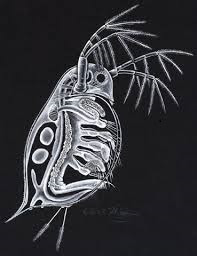Daphnia are a zooplankton, meaning that they are animals (zoo) that live at the water's surface, drifting with the currents (plankton). But daphnia are not just any zooplankton... they can live in incredible conditions!
Studies show that daphnia can live in slightly salty water like you would find where a stream meets an ocean (estuary) and that they manage small levels of salt just as well as completely freshwater! This is incredible. If a human were stranded on a boat in even mildly salty water, they would not be able to survive drinking it because the salt would just make them thirstier - but daphnia can.
 |
| A healthy daphnia (left) with a daphnia producing hemoglobin (right). |
And here is something even more incredible: if the water source is not changed for the daphnia and they start to use up all their oxygen, they create the same chemical that we have in our blood (hemoglobin) to bind oxygen - making their oxygen intake much more efficient (and turning them slightly reddish colored). That's crazy! Think if you were trapped in your classroom without an air supply and everyone breathing up all the oxygen, pretty soon you would feel super lightheaded, but daphnia have a mechanism to be able to survive days longer in an environment without a lot of oxygen.
If you think that is cool, just wait until you get to watch a trout chase a daphnia around a glass in our feeding experiments. We will have videos and more results of our live feedings coming by the end of next week, stay tuned!
You can check out more about daphnia through our worksheet and a slideshow shared by our teacher program on the teachers' tab of this blog.
-Originally posted January 29, 2021 by Marina Howarth




